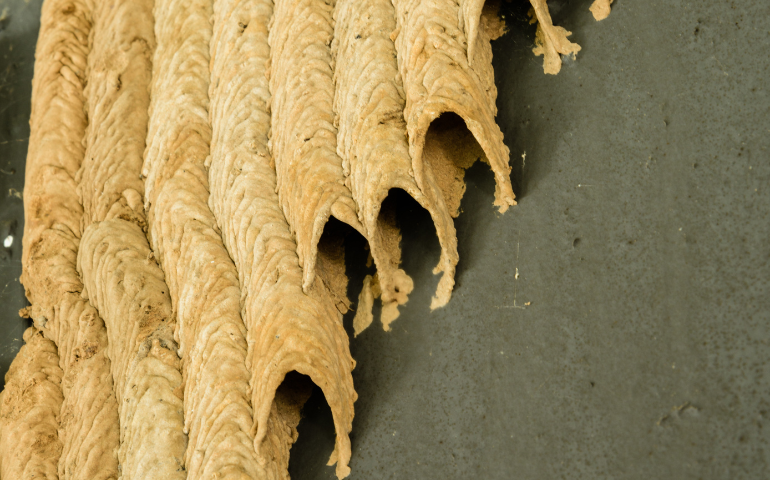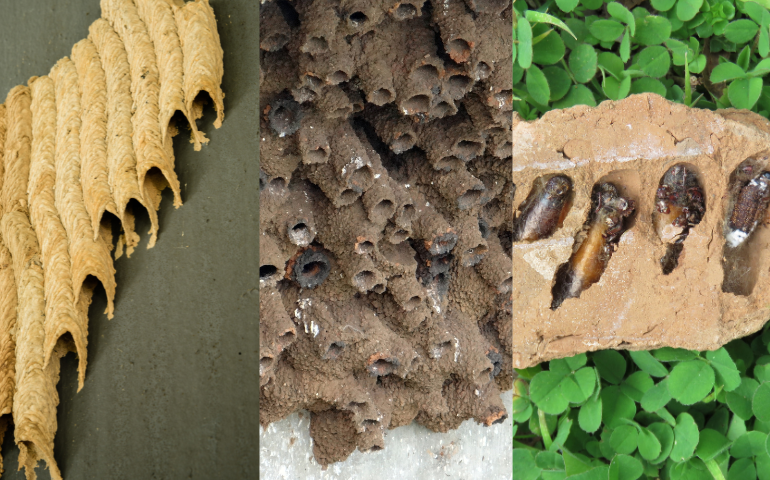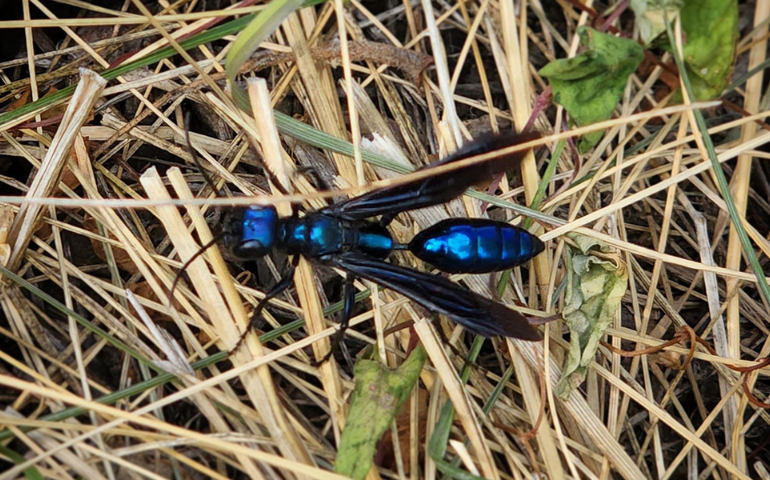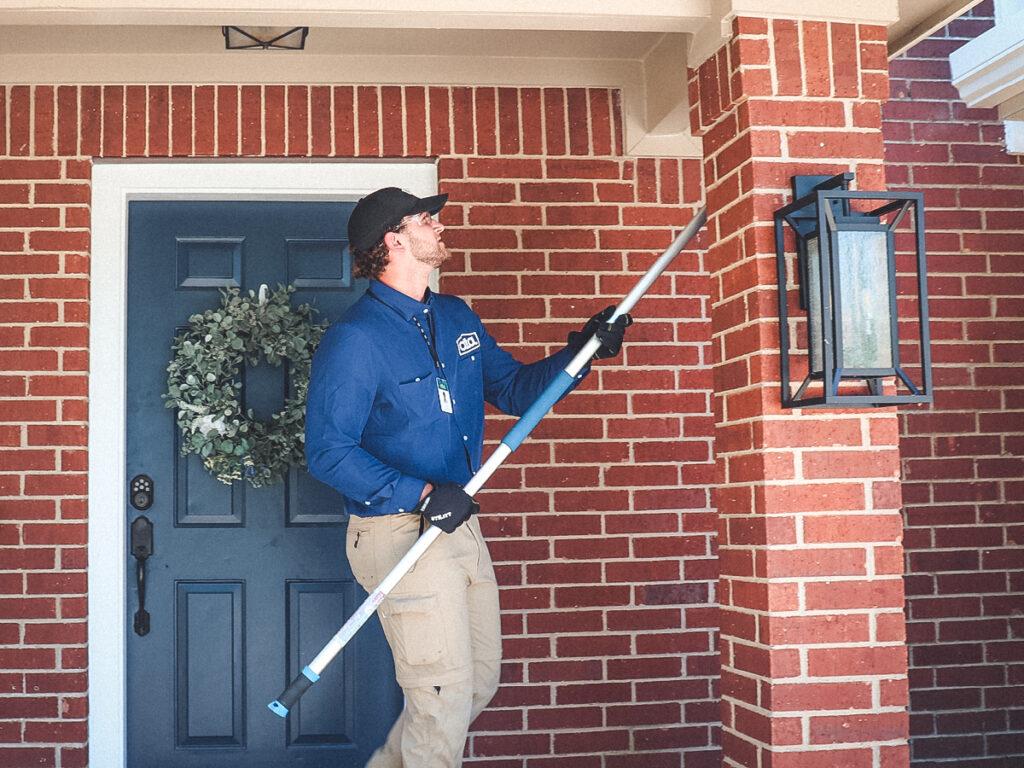Dirt dauber nests are a common sight around homes, especially in warmer months. These small, mud-built structures might seem harmless, but they often raise questions about what’s inside and whether they pose a threat to our property or safety. While dirt daubers are generally non-aggressive, their nests can still become an unwelcome addition to our outdoor spaces.
As pest control experts, we know how important it is to understand the habits of these insects and how to handle their nests effectively. Whether you’re dealing with an active nest or just curious about these fascinating creatures, it’s essential to know when to let them be and when to take action. Let’s explore what makes dirt dauber nests unique and how we can keep our homes pest-free.
Key Takeaways
- Dirt dauber nests are mud-built structures created by solitary wasps, often found on walls, ceilings, or sheltered outdoor surfaces.
- Despite their intimidating appearance, dirt daubers are non-aggressive and rarely sting unless provoked, differentiating them from social wasps like hornets.
- These insects play an essential ecological role by controlling spider populations and contributing to natural habitat balance.
- While dirt dauber nests are not harmful, they may cause minor issues, such as surface staining or vent blockages, making regular inspection essential.
- Safe nest removal involves protective gear, proper timing, and gentle methods, while preventive actions like sealing cracks and reducing spider populations help deter future nesting.
- Understanding dirt dauber behavior promotes coexistence and effective pest management without disrupting the environment.
What Is A Dirt Dauber Nest?

A dirt dauber nest is a structure built from mud by dirt daubers, also known as mud daubers or mud wasps. These solitary wasps create their nests using collected mud, forming tube-like or dome-shaped clusters on walls, ceilings, or protected surfaces around homes and outdoor structures. Each tube typically houses individual larval cells, stocked with paralyzed insects or spiders as food.
Dirt dauber nests are distinct from mud hornet nests or other wasp nests in appearance and function. Unlike social wasps, such as hornets, dirt daubers are non-aggressive and rarely sting unless directly provoked. Their nests serve solely as a breeding site, without the communal defensive behavior seen in other species.
While these nests aren’t usually a threat to humans, their presence can cause inconvenience. Nest material can stain surfaces or block vents. If left unchecked, they might attract other mud bees or mud daubers to the area due to favorable nesting conditions. Regular inspection and removal, where necessary, helps maintain a clean environment around your property.
Identifying A Dirt Dauber Nest
Dirt dauber nests, also called mud dauber wasp nests, are unique mud structures created by solitary wasps. Recognizing these nests helps address concerns about their presence near your home.

Appearance And Structure
Dirt dauber nests are composed mainly of mud, often mixed with twigs or organic material. Their shape and design vary based on the species:
- Organ Pipe Mud Dauber: Builds nests as cylindrical tubes resembling organ pipes or pan flutes. These tubular nests are elongated and stand out due to their distinct structure.
- Black and Yellow Mud Dauber: Creates simple, cigar-shaped clusters of one to three cells, typically attached to cracks, corners, or crevices. These nests often appear as clumped mud masses.
- Variations: Some nests resemble large, circular mud formations or consist of shorter mud tubes placed side by side, approximately 1 inch (25 mm) in length.
Inactive nests display round exit holes, which indicate that the wasps have emerged, leaving the structure abandoned, especially after spring.
Common Locations
Dirt daubers select sheltered areas to construct their nests, reducing the risk of weather damage. Commonly chosen locations include:
- Building exteriors, such as walls or eaves.
- Garages, sheds, or under porches.
- Crevices and corners around windows or doors.
- Structural gaps, vents, or pipes.
Being aware of where these nests may appear makes it easier to inspect and, if necessary, take action to remove them.
The Role Of Dirt Daubers In Nature
Dirt daubers, often mistaken for aggressive wasps, fulfill essential ecological functions. As solitary insects, they contribute significantly to maintaining balance in natural habitats.

Benefits To The Ecosystem
Dirt daubers control spider populations by paralyzing and using them as food for their larvae. This behavior prevents the overpopulation of certain spider species, indirectly supporting biodiversity. Their nesting habits also recycle mud, aiding in soil aeration and the natural movement of minerals, especially in locations like walls, bridges, and crevices where mud is sourced. Unlike social wasps, dirt daubers are generally non-aggressive, rarely posing a threat through stings unless provoked.
Prey And Predator Relationships
As predators, dirt daubers target a variety of spiders, including potentially harmful species like black widows. Each mud dauber wasp nest houses multiple spiders, ensuring enough nourishment for growing larvae. By preying on spiders, they manage spider populations naturally. Conversely, dirt daubers themselves serve as prey for birds and larger insects, making them an integral part of the food web. Understanding this relationship underscores the importance of dirt daubers in both pest control and ecosystem stability.
Are Dirt Dauber Nests Harmful?
Dirt dauber nests, often mistaken for mud hornet nests or mud beehives, are generally not harmful to humans or property in most situations. These unique mud-built structures are created by solitary mud wasps, also known as dirt daubers, which play important ecological roles.
Addressing Misconceptions
Mud daubers are commonly confused with aggressive wasps, but their behavior is distinct. Unlike social wasps, they don’t defend their nests or exhibit territorial aggression. While their nests may appear intimidating, dirt daubers are non-aggressive and rarely sting. This distinction sets them apart in the mud dauber vs wasp comparison.
Their primary focus is on hunting and paralyzing spiders to stock their mud cells with food for their larvae. Instances of dirt daubers stinging humans are rare and generally occur only when these insects feel directly threatened or mishandled. Most nest-related concerns are aesthetic, like surface staining or minor inconvenience from blocked vents.
Potential Risks And Concerns
Stinging Risk
Though mud daubers can sting, their venom is specialized for immobilizing prey, not for self-defense. The pain from a mud wasp sting is generally mild and short-lived. However, individuals allergic to wasp venom may face serious health risks if stung, including difficulty breathing or significant swelling.
Nest Locations
Nests sometimes cause minor issues by forming near vents or in structural gaps. While they don’t damage property, early nest removal helps avoid buildup and reduces the chance of attracting additional dirt daubers to the area. Our team at Alta Pest Control recommends inspecting problem areas regularly for the best results.
Understanding the habits of dirt daubers helps minimize concerns while maximizing coexistence.
How to Deal With Dirt Dauber Nests & Get Rid of Dirt Daubers
Dirt daubers (also called mud daubers or mud wasps) are solitary insects known for building distinctive mud nests. While they’re not aggressive, their nests can be unsightly and a nuisance when they build them around homes and businesses.

Professional Nest Removal
At Alta Pest Control, we take care of dirt dauber nests for you, so you don’t have to worry about handling them yourself. Our team is trained to remove these nests safely and effectively, ensuring your home remains free from unwanted pests.
- Thorough Removal – We carefully remove mud dauber nests without damaging your walls, eaves, or other surfaces.
- Proper Cleanup – After removing the nests, we clean the area to prevent dirt daubers from returning to the same spots.
- Quarterly Treatments – Our ongoing service plan helps prevent dirt daubers from coming back by treating your home every season.
Preventing Future Nests
Stopping dirt daubers from nesting on your property requires more than just knocking down their nests. Our pest control services include:
- Barrier Treatments – We apply treatments around your home to deter wasps and other insects.
- Regular Inspections – Our team checks for signs of new nests during routine visits, removing them before they become a problem.
- Reducing Attractants – Since dirt daubers prey on spiders, we help manage spider populations to make your home less inviting to them.
Let Us Handle It
Instead of worrying about dirt dauber nests on your own, let Alta Pest Control take care of them for you. With our quarterly treatments and expert service, we keep your home pest-free year-round. Contact us today to schedule a treatment and prevent future infestations.
Frequently Asked Questions
What is a dirt dauber nest?
A dirt dauber nest is a mud structure built by solitary wasps called dirt daubers or mud wasps. These nests consist of multiple cells where the wasp stores paralyzed prey to feed its larvae. They are commonly found on walls, in garages, or structural openings.
Are dirt daubers dangerous?
No, dirt daubers are not aggressive and rarely sting unless provoked. They are different from social wasps like hornets and pose little danger to humans.
How can I identify a dirt dauber nest?
Dirt dauber nests are made of mud and can vary in shape depending on the species, such as long tubes or small clusters. Inactive nests often have round exit holes.
Do dirt dauber nests damage property?
Dirt dauber nests can stain walls or block vents, causing inconvenience but minimal structural damage. Regular inspection and cleaning can prevent such issues.
What are the ecological benefits of dirt daubers?
Dirt daubers help control spider populations and contribute to biodiversity. Their nesting activities aid soil aeration and the natural movement of minerals.
How can I safely remove a dirt dauber nest?
Remove nests in the evening when wasps are less active. Wear protective gear and carefully detach the nest without damaging surfaces. Clean the area afterward to deter re-nesting. Or just call a pest control professional to take care of it for you and prevent them from coming back.
How can I prevent dirt daubers from building nests?
Seal cracks and gaps in structures, use natural deterrents, conduct regular inspections, and reduce the local spider population to make your home less attractive to dirt daubers.
Should I call a professional for dirt dauber nest removal?
If you are uncomfortable removing a nest or handling wasps, it’s best to contact a pest control professional to ensure safe and effective removal.
Are dirt dauber nests harmful to humans?
Generally, dirt dauber nests are not harmful to humans. Their main inconvenience is from stained surfaces or blocked areas. Their wasps rarely sting unless directly threatened.
Share article:
